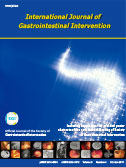
pISSN 2636-0004
eISSN 2636-0012
ABOUT THE IJGII
ARTICLE CATEGORY
ALL ARTICLES
For Contributors
-
POLICY



 pISSN 2636-0004
eISSN 2636-0012
pISSN 2636-0004
eISSN 2636-0012
 All Articles
All Articles
 Articles
Articles

Abstract : An arteriovenous fistula of the superior mesenteric vessels leading to pseudoaneurysm formation is rare and most commonly occurs after blunt trauma or surgery. We describe a case of a superior mesenteric artery?superior mesenteric vein (SMA/SMV) pseudoaneurysm that was initially misinterpreted as an enlarging hypervascular nodal metastasis on surveillance computed tomography (CT) in a patient who had undergone ileal carcinoid resection. When the case was discussed at the specialist multidisciplinary meeting to consider surgical resection, it was noted that the apparent “hypervascular node” on CT had a signal void character on magnetic resonance imaging, which is atypical for a lymph node. Coronal CT reformat demonstrated a vascular origin from the superior mesenteric trunk. This resulted in the correct diagnosis of a pseudoaneurysm secondary to an SMA/SMV fistula. This avoided an unnecessary repeat surgery, and the patient underwent endovascular repair. In our patient, the distal was closed by 3-mm coils and the proximal was closed by an Amplatzer plug with successful results. Hence, it is crucial for radiologists to have a systematic approach and understanding of vascular-related abnormalities to avoid misdiagnosis that can potentially lead to unwanted morbidity.
Cited By: 0

Abstract : We present a case of medulloblastoma metastatic to the pancreas in a 41-year-old woman with recurrent cerebellar medulloblastoma. On presentation, computed tomography of the abdomen and pelvis showed a 2.2 cm × 2.6 cm hypodense pancreatic head mass associated with obstruction of the pancreatic duct. Endosonography with fine needle aspiration (EUS-FNA) was performed. Cytology showed a malignant small cell neoplasm that was consistent with medulloblastoma and was morphologically identical to the primary cerebellar medulloblastoma. Metastatic medulloblastoma to the pancreas is an extremely rare form of a secondary pancreatic tumor and very few case reports exist in the literature. The diagnosis rests on comparing cytological features when primary and secondary tumors are both available.
Cited By: 1

Int J Gastrointest Interv 2023; 12(2): 64-68
https://doi.org/10.18528/ijgii220018
George Zhang  , Hayden Matthews
, Hayden Matthews  , Osanna Wong
, Osanna Wong  , and Dylan Kurda
, and Dylan Kurda 
Int J Gastrointest Interv 2022; 11(3): 143-148
https://doi.org/10.18528/ijgii210021
Soo-Young Na  , Seong Jung Kim
, Seong Jung Kim  , and Hyoun Woo Kang
, and Hyoun Woo Kang 
Int J Gastrointest Interv 2023; 12(3): 105-109
https://doi.org/10.18528/ijgii230002
Shuji Kariya, Shintaro Yamamoto 
 , Miyuki Nakatani
, Miyuki Nakatani  , Yasuyuki Ono
, Yasuyuki Ono  , Takuji Maruyama
, Takuji Maruyama  , and Noboru Tanigawa
, and Noboru Tanigawa 
Int J Gastrointest Interv 2022; 11(4): 186-191
https://doi.org/10.18528/ijgii220052
Jen-Jou Wong  , Srujana Ganti, Damian Mullan, Derek Edwards, and Hans-Ulrich Laasch
, Srujana Ganti, Damian Mullan, Derek Edwards, and Hans-Ulrich Laasch
Int J Gastrointest Interv 2021; 10(1): 12-16
https://doi.org/10.18528/ijgii190013
Thomas G. Morgan  , Tarryn Carlsson
, Tarryn Carlsson  , Eric Loveday
, Eric Loveday  , Neil Collin
, Neil Collin  , Graham Collin
, Graham Collin  , Peter Mezes
, Peter Mezes  , and Anne M. Pullyblank
, and Anne M. Pullyblank 
Int J Gastrointest Interv 2021; 10(1): 17-22
https://doi.org/10.18528/ijgii200018


 pISSN 2636-0004
eISSN 2636-0012
pISSN 2636-0004
eISSN 2636-0012
| TODAY | 52 |
|---|---|
| TOTAL | 233,312 |
© The Society of Gastrointestinal Intervention. Powered by INFOrang Co., Ltd.